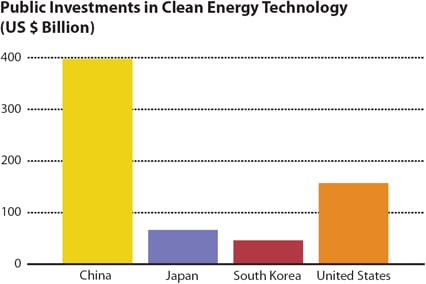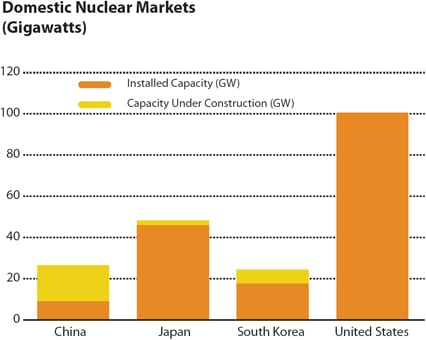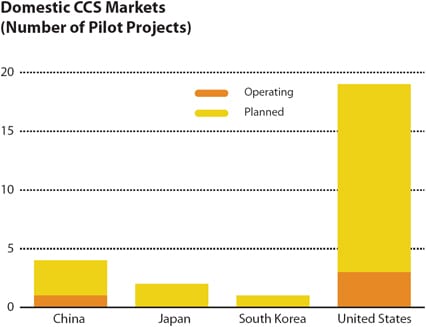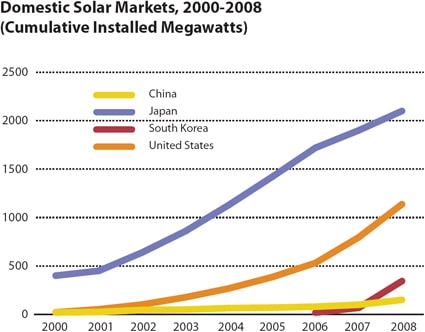Rising Tigers, Sleeping Giant
Asia’s rising “clean technology tigers”—China, Japan, and South Korea —are poised to out-compete the United States for dominance of clean energy markets due to their substantially larger government investments to support research and innovation, manufacturing capacity, and domestic markets, as well as critical related infrastructure. Government investment in each of these Asian nations will do more to reduce investor risk and stimulate business confidence than currently proposed U.S. climate and energy legislation, which includes too few aggressive policy initiatives and allocates relatively little funding to directly support U.S. clean energy industries. Even if climate and energy legislation passed by the U.S. House of Representatives becomes law, China, Japan and South Korea will out-invest the United States by a margin of three-to-one over the next five years, attracting much if not most of the future private investment in the industry. Global private investment in renewable energy and energy efficient technologies alone is estimated to reach $450 billion annually by 2012 and $600 billion by 2020, and could be much larger if recent market opportunity estimates are realized. For the United States to regain economic leadership in the global clean energy industry, U.S. energy policy must include more direct and coordinated investment in clean technology R&D, manufacturing, deployment, and infrastructure.
The governments of China, Japan, and South Korea are investing heavily to develop clean technology manufacturing and innovation clusters in order to gain a “first-mover” advantage in key clean energy sectors. Direct government investments will help China, Japan, and South Korea form industry clusters, like Silicon Valley in the United States, where inventors, investors, manufacturers, suppliers, universities, and others can establish a dense network of relationships and an attractive business environment that can create an enduring competitive advantage for these nations.
Asia’s clean tech tigers are already on the cusp of establishing advantage over the United States in the global clean tech industry. This year China will export the first wind turbines destined for use in a U.S. wind farm, for a project valued at $1.5 billion. With no domestic manufacturers of high-speed rail technology, the United States will rely on companies in Japan or other foreign countries to provide rolling stock for any planned high-speed rail lines. And all three Asian nations lead the United States in the deployment of new nuclear power plants. The United States relies on foreign-owned companies to manufacture the majority of its wind turbines, produces less than 10 percent of the world’s solar cells, and is losing ground on hybrid and electric vehicle technology and manufacturing. As the Rising Tigers report demonstrates, the United States lags far behind its economic competitors in clean technology manufacturing. Should this gap persist, the United States risks importing the majority of the clean energy technologies necessary to meet growing domestic demand.
Since emerging clean energy technologies remain more expensive than conventional alternatives and face a variety of non-price barriers, public sector investments in clean energy will be a key factor in determining the location of clean energy investments made by the private sector. The direct and targeted public investments of China, Japan, and South Korea are likely to attract substantial private investment to clean energy industries in each country, perhaps more so than the market-based and indirect policies of the United States.
As trillions of dollars are invested in the global clean energy sector over the next decade, clean tech firms and investors will invest more in those countries that offer support for infrastructure, R&D, a trained workforce, guaranteed government purchases, deployment incentives, lower tax burdens, and other incentives. In China, for example, state and local governments are offering firms free land and R&D money, and state-owned banks are offering loans to clean tech firms at much lower interest rates than those available in the United States.
There are historic examples of the United States catching up to competitors who have surged ahead. The United States raced past Europe in aerospace through sustained federal military-related support for aviation technology development and deployment, and was able to become a world leader in civil and military aviation, after trailing Europe for years. During the space race, the United States quickly met and then surpassed the Soviet Union after it launched the Sputnik satellite, putting a man on the moon twelve years later after a sustained program of direct investment in innovation and technology. The United States has consistently been a leader in inventing new technologies and creating new industries and economic opportunities. It remains one of the most innovative economies in the world and is home to the world’s best research institutions and most entrepreneurial workforce. The challenge will be for the United States to aggressively build on these strengths with robust public policy and government investment capable of establishing leadership in clean technology development, manufacturing, and deployment, and to do so before China, South Korea and Japan fully establish and cement their emerging competitive advantages.
The following figures and tables are taken from Rising Tigers, Sleeping Giant: Asian Nations Set to Dominate the Clean Energy Race by Out-investing the United States, a report by the Breakthrough Institute of Oakland, California, and the Information Technology and Innovation Foundation of Washington, DC. The full report is available at http://thebreakthrough.org/blog/rising_tigers.pdf.
The clean energy investment gap
China, South Korea, and Japan will invest a total of $509 billion in clean technology (solar, wind, and nuclear power; energy efficiency; advanced vehicles; high-speed rail, and carbon capture and sequestration) over the next five years (2009-2013), whereas the United States will invest $172 billion, a sum that assumes the passage of the proposed American Clean Energy and Security Act and includes current budget appropriations and recently enacted economic stimulus measures.
Research and innovation
The United States currently invests slightly more money in research and development than does Japan and has an advantage over China and South Korea. However, each Asian competitor is moving to close the innovation funding gap. Furthermore, as a percentage of each nation’s gross domestic product, Japan and South Korea out-invest the United States on energy innovation by a factor of two-to-one. The United States secures 20.2% of the world’s clean energy patents, more than any country in the world, but Japan is a close second.
Clean energy manufacturing
The United States has fallen behind its economic competitors, especially China, in the capability to manufacture and produce clean energy technologies on a large scale. The United States trails China and Japan in solar PV, China in wind, and all three Asian nations in nuclear. The three Asian nations now have their own domestic nuclear reactor designs, whereas the United States has seen a decline in nuclear engineering facilities and does not have the large heavy forging capacity necessary to produce full nuclear reactor sets.
The United States is currently being aggressively challenged by its Asian competitors in the development of plug-in hybrid and electric vehicles, and is lagging behind in the production of the advanced batteries that will power them. China, Japan, and South Korea collectively manufacture over 80% of the world’s lithium-ion batteries. The United States does not manufacture any truly high-speed trains, and all future plans for high-speed rail deployment may require international imports
Domestic clean energy markets
The United States currently leads China, Japan, and South Korea in the domestic market development of two of the six technologies, wind power and carbon capture and storage (CCS) technology. With respect to advanced vehicles, domestic markets are still nascent, and a clear world leader has yet to emerge.
The United States currently lags behind its competition in market development for nuclear power and high-speed rail (HSR). Despite having the world’s largest installed nuclear power capacity, the United States has no new nuclear power plants under construction, whereas China leads with seventeen. Whereas the United States has no HSR capacity to speak of and is still years away from breaking ground on the nation’s first true high-speed line, each of its three Asian competitors has a large and growing domestic market for this clean technology.







